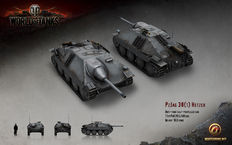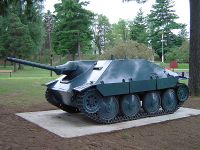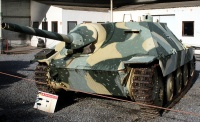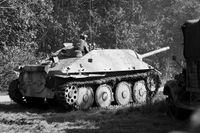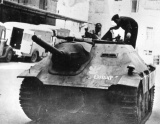Jagdpanzer 38(t) Hetzer
| Revision as of 18:06, 16 September 2011 6.7 Stats added | Revision as of 18:06, 16 September 2011 | |||
| Line 25: | Line 25: | |||
| |aim = 1.5 | |aim = 1.5 | |||
| |fire = 20 | |fire = 20 | |||
| ? | |parent = {{contour|Marder II, PzKpfw 38(t)}} | + | |parent = {{contour|Marder II, PzKpfw 38 (t)}} | |
| |child = {{contour|StuG III}} | |child = {{contour|StuG III}} | |||
| }} | }} | |||
Revision as of 18:06, 16 September 2011
Hetzer
| Germany | TD | Tier IV |
The Hetzer is a German tier 4 tank destroyer. It is a very different tank from its predecessor, the Marder II. Initially, its poor speed and restricted arc of fire seem to be a downgrade from the long-range firepower of the Marder II; a point that provokes a lot of mixed opinions from players. It takes some time, and a few upgrades, to unlock some of the Hetzer's true potential and allow its excellent sloped armor, low profile, and powerful guns to come to the force. The Hetzer is an excellent ambush tank and a decent sniper, while being able to sustain a surprising amount of damage: provided you can keep the enemy within your frontal arc. This sets the tone for much of the German tank destroyers line. Most of all, it is important to remember: "Hetzer's gonna Hetz".
- Research leads to the StuG III.
Modules
Historical Info
The Jagdpanzer 38(t) (Sd.Kfz. 138/2), later known as Hetzer ("baiter"), was a German light tank-destroyer of the Second World War based on a modified pre-war Czechoslovakian Panzer 38(t) chassis. The project was inspired by the Romanian "Mareşal" tank destroyer.
The name "Hetzer" was, at the time, not commonly used for this vehicle. It was the designation for a related prototype, the E-10. The Škoda factory (for a very short period) confused the two names in its documentation, and the very first unit equipped with the vehicle (for a few weeks) applied the incorrect name until matters were cleared. However, there exists a memorandum from Heinz Guderian to Hitler incorrectly claiming that an unofficial name, Hetzer, had spontaneously been coined by the troops. Post-war historians, basing themselves on this statement, made the name popular in their works. The vehicle was never named as such in official documents.
Development
The Jagdpanzer 38(t) was intended to be more cost-effective than the much more ambitious Jagdpanther and Jagdtiger designs of the same period. Using a proven chassis, it avoided the mechanical problems of the larger armored vehicles.
It was better armored than the earlier Panzerjäger Marder and Nashorn with a sloped armor front-plate of 60 mm, sloped back at 60 degrees from the vertical (equivalent in protection to about 120 mm), carried a reasonably powerful gun, was mechanically reliable, small, and easily concealed. It was also cheap to build. The Jagdpanzer 38(t) succeeded the Marder III (based on the same chassis) in production from April 1944: about 2,584 were built until the end of the war. The older Marder III Panzerjager-series retained the same vertically-sided chassis as Panzer 38(t). In the Hetzer, the lower hull-sides sloped slightly to increase the available interior space and enable a fully-enclosed fighting compartment. Because of the fully enclosed armor, it was 5 tons heavier than the Marder III. To compensate for the increased weight, track shoe width was increased from 293 mm to 350 mm. Additionally, in late 1944, Guderian ordered the petrol engine replaced by a 190hp air-cooled Tatra Type 928 diesel engine, a result of Germany's rapidly diminishing supply of petrol fuel. This change was not immediately implimented to prevent disruption of production, but by spring 1945, Tatra diesel-powered Hetzers were emerging from factories.
The Hetzer equipped the Panzerjägerabteilungen (tank-destroyer battalions) of the infantry divisions, giving them some limited mobile anti-armor capability. After the war, Czechoslovakia continued to build the type (versions ST-I and ST-III for training version: about 180 units built) and exported 158 vehicles (version G-13) to Switzerland. Most vehicles in today's collections are of Swiss origin.
By order of Adolf Hitler in November 1944, a number of Jagdpanzer 38(t)s were refurbished straight from the factory with a Keobe flamethrower and accompanying equipment instead of the normal gun. The flame projector was encased in a metal shield reminiscent of that of a gun barrel, and easily prone to damage. Less than 50 of these vehicles, designated Flammpanzer 38, were completed before the end of the war, but they were used operationally against Allied forces on the Western Front. Further variants were a Hetzer carrying the 150 mm sIG33/2 Howitzer, of which 30 were produced before the end of the war, and the Bergepanzer 38(t)Hetzer, a light recovery vehicle of which 170 were produced. Plans were made to produce other variants, including an assault-gun version of the Hetzer carrying a 105mm StuH main cannon, and an anti-aircraft variant mounted with a flak turret. The war ended before these proposed models were put into production.
Performance
The Jagdpanzer 38(t) fitted into the lighter category of German tank-destroyers that began with the Panzerjäger I, continued with the Marder series, and ended with the Jagdpanzer 38(t). The 75 mm gun fitted on the Jagdpanzer 38 (t) was a modified 75 mm Pak 39 L/48, very similar to the late Panzer IV marks. The 75 mm kwk 40 L/48 could destroy nearly all allied tanks in service at long ranges, and its fully-enclosed armor protection made it a safer vehicle to crew than the Marder II or Marder III series. The Jagdpanzer 38(t) was one of the most common late-war German tank-destroyers. It was available in relatively large numbers and was generally mechanically reliable. Also, its small size made it easier to conceal than larger vehicles.
Like some other late-war German SPGs, the Hetzer mounted a remote-control machine gun mount which could be fired from within the vehicle. This proved popular with crews, though to reload the gun, a crewmember needed to expose themselves to enemy fire.
Its main failings were comparatively thin armor, limited ammunition storage, as well as torsion-bars and drive wheels that were prone to failure due to the increased weight of the Hetzer body on the Type 38 (t) suspension.
